Engineers and procurement face tight deadlines, complex part geometries, and no room for error. They use traditional methods to shape the material. Sometimes, these old methods change the whole geometry of materials. The CNC is too slow, stamping needs costly dies, and laser cutting can bury your thin materials. However, the chemical etching solves those headaches.
The chemical etching process gives you accurate metal parts without using heat and heavy tools. It’s a smart choice for the aerospace, medical, electronics, and automotive industries. Additionally, it’s fast and low-cost for small runs and doesn’t need expensive tooling. So, the engineering teams can test designs and make sensor components.
Read the guide to explore how does chemical etching works, along with additional benefits, applications, and chemical etching manufacturer. So, keep reading!
What Is Chemical Etching? A Modern Solution for Complex Metal Parts
Chemical etching is a machining process used to make precise, detailed parts from metal sheets. It’s working on the principle of controlled chemical reactions. Instead of cutting with tools, it removes material with a liquid chemical called an etchant.
The most common etchant is ferric chloride (FeCl₃). It reacts with the exposed areas of metal and dissolves them quickly. Once the etching is complete, the protective film is removed. However, it does not change the metal’s structure.
Advantages of Chemical Etching
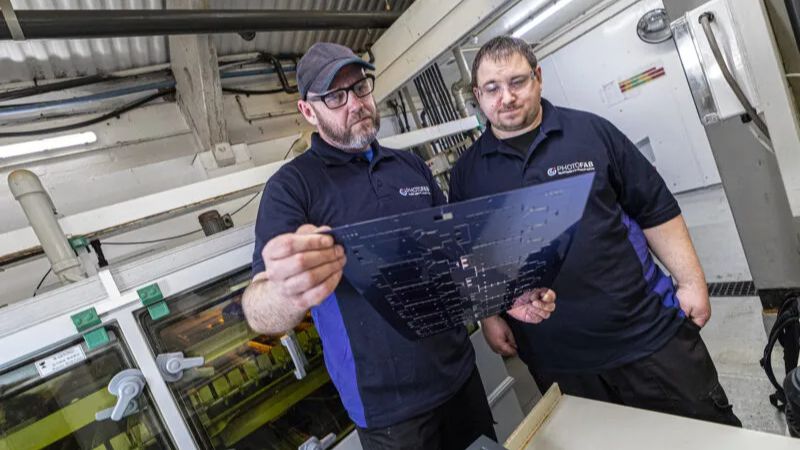
The above stats show the global market value of chemical etching. The engineers chose the chemical etching because it solves problems that cutting, stamping, or laser methods can’t. It allows for fine detail, no material stress, and tight tolerances.
TMNetch’s offers high-precision chemical etching services for parts that require clean edges and fine details. They adopt controlled chemical reactions to remove metal without heat or stress. TMNetch can work with metal sheets as thin as 0.01 mm and hold tolerances as tight as ±10 microns. This makes it ideal for creating sharp lines, tiny holes, and complex patterns. The company makes metal sheets with the same accuracy and quality every time.
Here are some other great advantages of chemical etching:
Burr‑free, stress‑free fabrication
Chemical etching uses no heat or force. That means no burrs, no cracks, and no stress in the metal. The parts stay flat and clean, and reduce the need for extra finishing work. In critical parts like aerospace sensors or medical screens, burrs can cause failures. Etching avoids that entirely.
Complex geometry
You can etch tiny holes, fine lines, woven patterns, or microchannels in one go. The chemical etching process works from a digital design. So, it can observe very detailed patterns of material. Sometimes, the parts that would bend or warp in stamping come out perfect with etching.
Fast iterations with no expensive tooling
In chemical etching, the engineers use low-cost digital phototools rather than expensive dies. These can cost under €120 (around $120) and be ready in under an hour. That means you can change the design quickly with low setup costs. Stamping, in contrast, often needs custom dies that cost thousands and take weeks to produce.
Ideal for high‑precision industries
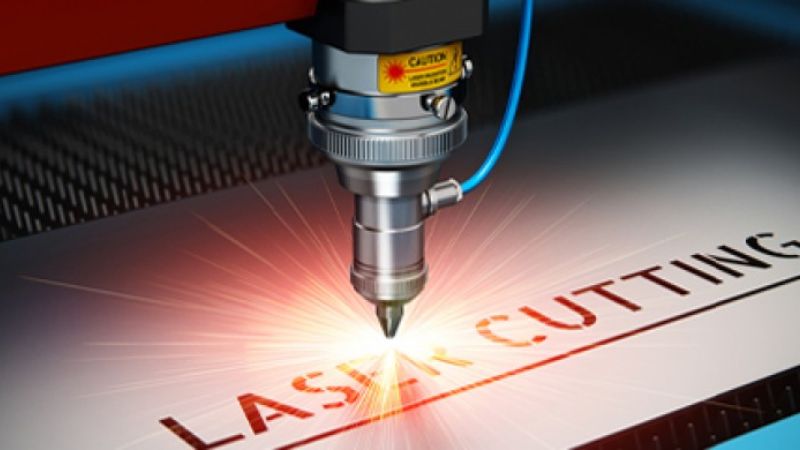
Chemical etching holds tight tolerances (±0.025 mm (±0.001 in)). It works well with thin materials down to 0.01 mm and up to about 1.5 mm thick. It’s used in aerospace fuel filters, medical microtools, electronic shielding, and automotive sensors. The engineers prefer chemical etching due to its accuracy and precision.
How Chemical Etching Works: Step-by-Step Breakdown
The chemical etching process follows a set of clear and tested steps. Each step requires detailed analysis and attention to detail, so the chances of errors become zero. Here is the step-by-step guide that helps you see exactly how it’s done.
Step 1: Metal preparation & cleaning
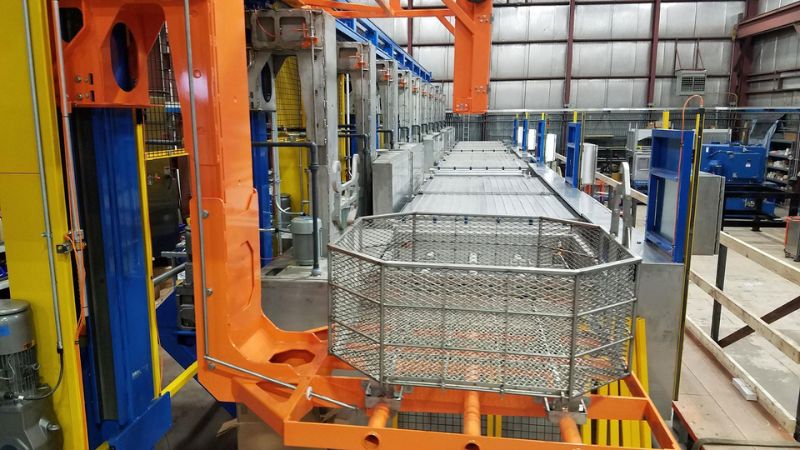
You can start the process of chemical etching by cleaning the metal sheet surface. Any dirt, oil, or oxidation can mess up the etching. So, scrub and degrease the surface using water-based cleaners or solvents. Even minor fingerprints can cause defects, so everything is kept clean and controlled.
Step 2: Photoresist application

Next, a light-sensitive coating called photoresist is applied to the metal. This coating serves as a protective layer for metal. When the coating is dry, you can place a digital or film-based mask with the part design. When the masking process is complete, expose the metal to UV lights. It hardens the resin.
Step 3: Developing & etching

It is a very crucial step of chemical etching. Now, the exposed part of the photoresist is washed with a mild developer. This opens the metal surface in just the right places. Then keep the spray of etchant, usually ferric chloride (FeCl₃), on the metal sheet. The chemical eats away the exposed metal in just a few minutes. It creates the final part shape with tight tolerances (±0.025 mm).
Step 4: Stripping, inspection & finishing
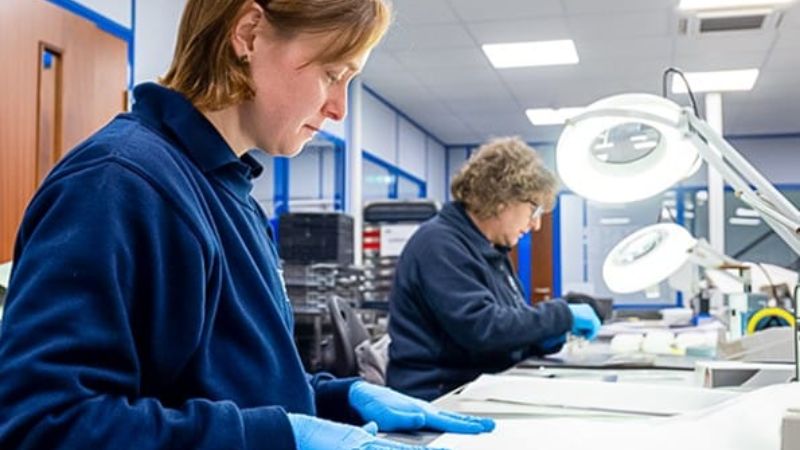
When the chemical etching is completed, you can remove the remaining photoresist with a mild chemical. This process shows the finished metal parts. It goes through inspection of visual checks or measurement tools like laser scanners or microscopes. Finally, the metal parts are rinsed, dried, and packed.
What Metals Can Be Chemically Etched? Material Compatibility Guide
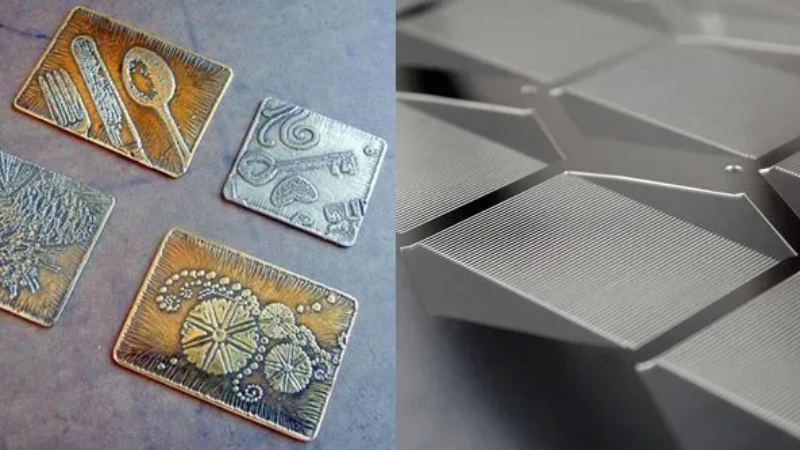
Chemical etching works best with different types of metals that respond consistently to etchants. But not all metals behave the same. Here is the category of best metals for chemical etching, along with their chemical formulas.
Common materials
The common metals used in chemical etching are
- Stainless Steel (Fe-Cr-Ni)
- Nickel Alloys (Ni-Cr-Fe)
- Copper (Cu)
- Beryllium Copper (CuBe or BeCu)
- Brass (Cu-Zn)
- Aluminum (Al)
Specialty materials
The special material the engineers use in the photo-chemical etching process includes
- Inconel (Ni-Cr-Fe-Mo)
- Titanium (Ti)
- Molybdenum (Mo)
- Gold (Au)
- Silver (Ag)
- Platinum (Pt)
Chemical Etching Applications: Real-World Use Cases
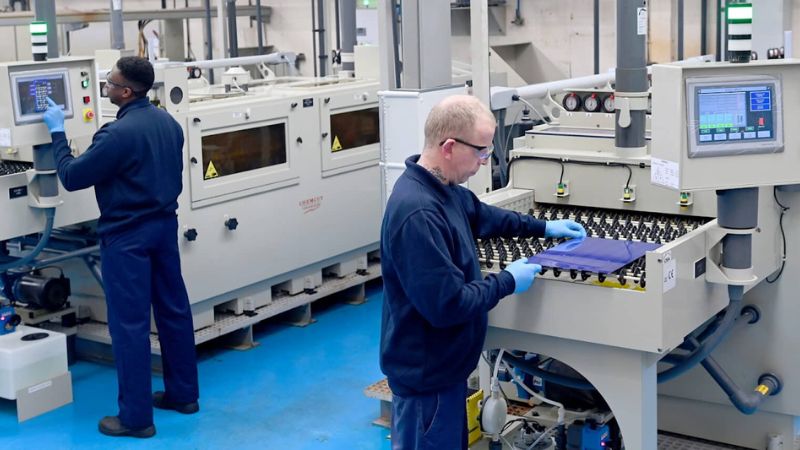
Chemical etching application is not just limited to the lab process. It’s work behind the scenes in things we use every day. Let’s take a closer look at which industry uses this process.
1- Aerospace & defense
In aerospace, every part must be light, reliable, and built to handle extreme conditions. Chemical etching is used to make lightweight components like
- EMI/RFI shielding
- Fuel system parts
- Cooling plates and screens
Etched parts reduce weight without giving up strength. They’re burr-free and avoid wear in tight assemblies.
2- Medical devices
Medical tools need to be safe, sterile, and extremely precise. Etching allows fine, clean details on small parts used in:
- Surgical blades
- Stents
- Implantable filters
- Diagnostic test strips
The no-heat process keeps metal properties stable. So, your equipment saves you from bacterial or HIV/AIDS viruses.
3- Electronics & semiconductors
From smartphones to satellites, the electronics industry depends on etched parts. Chemical etching is used for:
- Circuit board components
- RF shields
- Lead frames
- Connector pins
It supports tight tolerances and fine features.
4- Automotive sensors & fuel systems
Modern cars use more electronics and sensors than ever. Etched parts play a role in:
- Fuel injector plates
- Battery contacts
- Pressure and flow sensors
These components need to resist heat, chemicals, and wear. Chemical etching makes these components in high volumes, fast, and without tooling costs.
Chemical Etching vs. Laser Cutting, CNC, and Stamping—Comparison Table
Chemical etching is 180 degrees different from laser cutting and stamping. Here is a detailed comparison that helps you to figure out why the automotive industries prefer chemical etching.
| Feature | Chemical Etching | CNC Machining | Laser Cutting | Stamping |
| Tolerances | ±0.025 mm (0.001 in) | ±0.1 mm (0.004 in) | ±0.05 mm (0.002 in) | Varies; depends on the precision |
| Burrs | None | Requires deburring | Minimal (depends on material/thickness) | High without secondary finishing |
| Setup Cost | Low (digital phototools only) | Medium (tool paths, fixtures) | Medium (calibration, programming) | High (custom dies and hard tooling) |
| Part Stress/Distortion | None | Possible due to cutting forces | Possible heat-affected zones | Common in thin or complex parts |
| Design Changes | Easy and low-cost | Time-consuming | Moderate effort | Expensive (requires new tooling) |
| Production Volume | Best for low to mid-volume | Low to mid-volume | Low to mid-volume | Best for high-volume only |
| Minimum Material Thickness | As thin as 0.01 mm (0.0004 in) | ~0.3 mm (0.012 in) | ~0.1 mm (0.004 in) | ~0.2 mm (0.008 in) |
Frequently Asked Questions
What is the principle of chemical etching?
The selective corrosion is the working principle of chemical etching for stainless steel. A chemical, called an etchant, reacts only with exposed metal areas. The etchant breaks down the metal’s surface by a chemical reaction. It removes unwanted parts of metal. The result is a clean, precise cut that follows the pattern exactly.
What are common chemical etching mistakes?
Engineers make mistakes unintentionally in the chemical etching process. Poor cleaning, selecting the wrong etchant, and mixing it poorly are common. If you don’t apply the photoresist in the right way, the coating pattern may peel. In some cases, the over-etching makes the metal part thinner and cuts too deeply. So, it’s important to pay attention to detail in every step of etching.
How accurate is chemical etching?
This process is known for its high precision and accuracy. It has tight tolerances that are often around ±0.025 mm. The tolerance depends on the material and design. Since there’s no heat or force involved, the metal parts stay flat and mold. You also don’t get burrs or rough edges. That means the final piece looks just like the design.
Final Thoughts
To summarize, chemical etching designs the metal parts and materials with fine details. This method gives clean results without using heat and keeps the metal strong.
As parts get smaller and more detailed, chemical etching will continue to grow. It saves time, lowers cost, and fits the needs of today’s fast-moving world. With the rise of medical tech and microelectronics, the future of chemical etching is very bright.
So, choosing the right chemical etching partner matters, too.
A trusted specialist like TMNetch provides deep experience and careful attention to every detail. They understand the quality standards. If you’re thinking about using chemical etching for your next project, TMNetch has helped many teams change ideas into high-precision parts.
